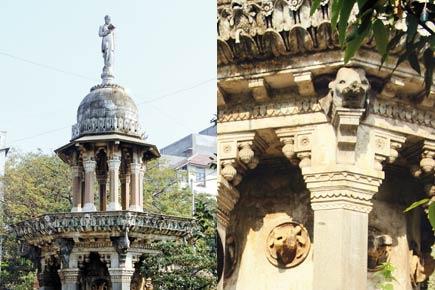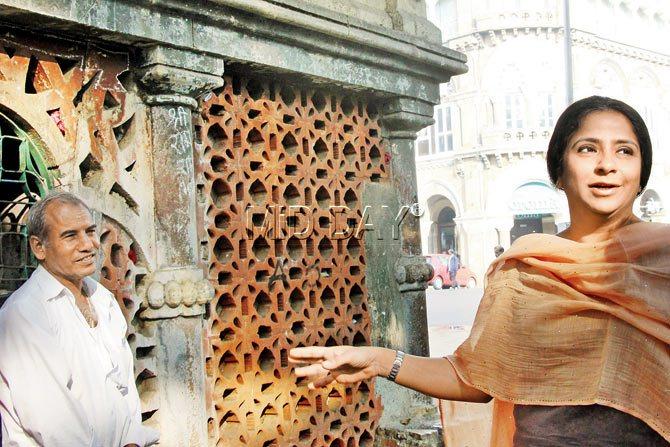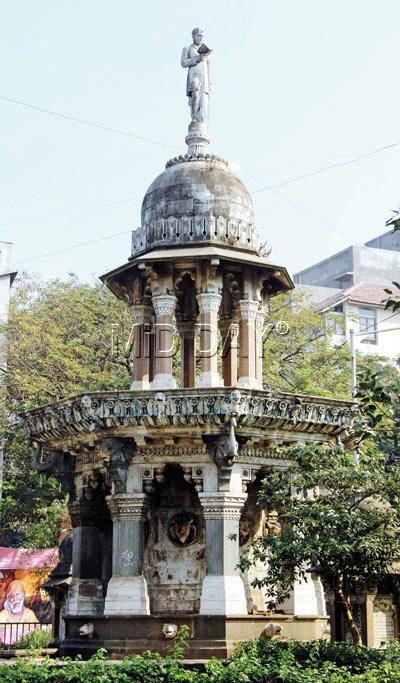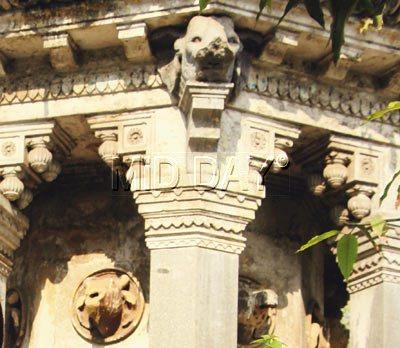Drink to the fountain and watch the clock rock. The Kala Ghoda Association's restoration efforts aim to bring alive Mumbai's derelict structures

Once a pristine, intricately carved water fountain, quenching the thirsts of animals and humans alike, the Muljee Jetha Fountain at the corner of Mint Road in Fort now is a dilapidated structure enclosed in a garden where many enjoy an afternoon siesta.

Kayomi Engineer (right) with Neelkanth Joshi, the fifth generation caretaker of the Seth Gangalal Mulji Nandlal Pyao. PicsS/Onkar Devlekar
ADVERTISEMENT
Designed in the Indo-Saracenic style — which interspersed elements of Mughal architecture to the base of Victorian Gothic style — by F W Stevens (the architect behind the Chhatrapati Shivaji Maharaj Terminus) and built by businessman Ruttonsee Mulji Jetha in memory of his deceased son, the fountain like many other historical relics in the city is in dire need of attention.
Artistically brilliant, the fountain has animal-head water spitters and stone chhtaris (umbrellas). However, when Sunday mid-day checked the fountain, we noticed that most of the inside of the spitters were completely broken, leaving behind nothing but stubs of stone.
There’s hope however.

The Muljee Jetha Fountain to be restored by next year
The Kala Ghoda Association (KGA) has taken the fountain under its wing and now plans to restore it. Maneck Davar, honorary chairperson, KGA, said, “The association has been working towards strengthening the identity of Kala Ghoda, and restoration of forgotten pieces of heritage is the perfect way to do it.”

The damaged water spitters of the Muljee Jetha Fountain, which will now be restore by the Kala Ghoda Association
While the area’s arts festival may be KGA’s most well-known project, Kala Ghoda itself has a strong visual image, reinforced by historic buildings, comprising the finest concentrated collection of heritage structures in the city.
The KGA will restore the water fountain for an estimated cost of R72 lakh and plans to complete it within a year’s time of starting work, which will begin shortly.
“The BMC was supposed to maintain this fountain, but they have not paid any attention to it. This fountain is going to take the longest among our two other projects to restore, given its size and the degree of damage its has suffered,” said Kayomi Engineer, administrative director, KGA.
When it was built, the fountain was meant to serve both humans and animals. Troughs at the bottom of the fountain were used by animals to drink water, while humans had their fill from the now damaged animal-head water spitters.
Conservation architect, Vikas Dilawari, in charge of the project, says, “Some spitters may only need a touch up, while some will need to be replaced entirely.”
Heads and tales
Replacing the animal heads is going to be a real challenge for Dilawari. The fountain has been painted over by the BMC under the label of ‘maintaining’ it and bringing it back to its original form, will take time and technique.
“Years of neglect and insensitive alterations are the biggest challenges when one looks at restoring heritage structures, followed with getting traditional materials and craftsmen, very difficult to source,” says Dilawari.
However, those looking forward to a restored fountain with jets of clear water may be disappointed. The KGA will not make the fountain functional.
“We fear that the fountain will be misused with people stealing the water and making a mess at the structure. The idea is to only restore the façade to keep its history alive,” says Engineer.
The KGA has plunged into its financial reserves to fund several restoration projects. The KGA, says Engineer, “through smart investments years ago,” has been able to commission these restoration projects. Also, a large part of the money collected from the Kala Ghoda Arts Festival is also being used for the project.”
Besides this, KGA has also taken up restoration of the Bomanjee Hormusjee Wadia Clock Tower, which stands at the junction of Bazaar Gate road and Nariman Perin Street. The clock which was recently vandalised and its hands and the glass covering the clock face stolen, already sheathed in scaffolding, is being restored at a cost of R65 lakh. The project has a timeframe of one year for completion.
Where history whispers
The Seth Gangalal V Mulji Nandlal Religious and Charitable Trust Pyao at Horniman Circle, is also on the KGA anvil. This Pyao (a drinking water fountain), which is replete with history is also easily missed. Tucked away in a corner outside the Horniman Circle Garden Gate, it is one of the oldest pyaos in the city.
The KGA has roped in the Urban Design Research Institute (UDRI) to restore and maintain the structure. This project is estimated to cost Rs 30 lakh and will be completed in 2017.
This small, yet charming fountain built in 1842, with terracotta jaali and beautiful stonework, is a two-storey structure that used to draw hordes of traders and merchants to slake their thirst.
History says that an underground well, located below the Horniman Circle garden, was excavated in 1811. Subsequently, Seth Gangadas Vijbhukhandas Shroff funded the establishment of the public pyao in 1842. The pyao stands on top of this well. Today, it lies unused and is crumbling, with its troughs serving as a bench to rest weary feet.
Continuing the legacy
Since 1842, a clan of water-bearers called ‘Bhatts’ drew and carried the water from the pyao to homes and work places. Some continue to do so, even today, said a beaming Joshi, a fifth generation descendant of the Shroff family. “I have lived here ever since my birth and tending to the pyao is a family business of sorts. While the water now is no longer fit for drinking, some years ago, a bore-well was dug next to pyao, from where, every morning Bhatts continue to draw the water, which is used to clean offices nearby.”
A large banyan tree next to the pyao, provides shade and succour for the hundreds that pass by.
The banyan’s long roots are coiled tightly around the trunk of the tree. Yet, it a large brass pot sitting at the foot of the tree that catches the eye and seems to have jumped right out of the history books. There was a time when pots like these were used to carry water from the well. Only this one remains, its rusty handles painting a picture of a bygone era.
 Subscribe today by clicking the link and stay updated with the latest news!" Click here!
Subscribe today by clicking the link and stay updated with the latest news!" Click here!







